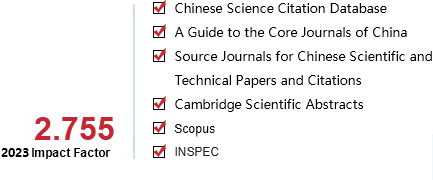[1]WEN Tianzhu,XU Aiqiang,DENG Lu.A new negative selection algorithm based on Extenics and its application in fault diagnosis[J].CAAI Transactions on Intelligent Systems,2015,10(3):488-493.[doi:10.3969/j.issn.1673-4785.201402020]
Copy
A new negative selection algorithm based on Extenics and its application in fault diagnosis
CAAI Transactions on Intelligent Systems[ISSN 1673-4785/CN 23-1538/TP] Volume:
10
Number of periods:
2015 3
Page number:
488-493
Column:
学术论文—机器学习
Public date:
2015-06-25
- Title:
- A new negative selection algorithm based on Extenics and its application in fault diagnosis
- Keywords:
- extenics; negative selection algorithm; detector generation; detector optimization; fault diagnosis
- CLC:
- TP18
- DOI:
- 10.3969/j.issn.1673-4785.201402020
- Abstract:
- In this paper, the extension negative selection algorithm is proposed by fusing Extenics and negative selection algorithm, aiming at the problem that traditional diagnosis algorithm can hardly solve fault detection by using normal state data. The basic elements are adopted to describe the models of problem domain, detectors and training samples, the dependent function is used to define the affinity calculation formula, and the extension detector generation and optimization algorithm are designed. In the phase of extension detector generation, the mature detectors are taken through the self-tolerance and in the phase of extension detector optimization, less mature detectors are taken through merging the detectors. The influence of threshold value of the degree of affinity on the coverage rate and detection rate of detectors are discussed in the parameter analysis. Finally, the proposed algorithm is used for fault detection of an integrated display and control platform. The obtained mature detectors not only have less numbers and are non-redundant, but also have high detection rate. The results showed that the algorithm can solve the fault detection problem in the condition of no fault state data and the detection results are consistent with the practive.
- References:
-
[1] DASGUPTAA D, YUA S, NINO F. Recent advances in artificial immune system: models and application[J]. Applied Soft Computing, 2011, 11(2): 1574-1587.
[2] 李红芳, 张清华, 谢克明. 一种新型免疫学习算法在故障诊断中的应用[J]. 智能系统学报, 2008, 3(5): 449-454.LI Hongfang, ZHANG Qinghua, XIE Keming. Application of a novel immune network learning algorithm to fault diagnosis[J]. CAAI Transactions on Intelligence Systems, 2008, 3(5): 449-454.
[3] 刘勇, 尚永爽, 王怡苹. 基于免疫模型的故障诊断方法及应用[J]. 计算机工程, 2011, 37(16): 5-7.LI Yong, SHANG Yongshuang, WANG Yiping. Fault diagnosis method based on immune model and its application[J]. Computer Engineering, 2011, 37(16): 5-7.
[4] CHEN Wen, LI Tao, LIU Xiaojie, et al. A negative selection algorithm based on hierarchical clustering of self set[J]. Science China: Information Sciences, 2013, 56(8): 1-13.
[5] CHEN Guangzhu, ZHANG Lei, BAO Jiusheng. An improved negative selection algorithm and its application in the fault diagnosis of vibrating screen by wireless sensor networks[J]. Journal of Computational and Theoretical Nanoscience, 2013, 10(10): 2418-2426.
[6] GAO X Z, WANG X, ZENGER K. Motor fault diagnosis using negative selection algorithm[J]. Journal of Computing and Application, 2014, 25(1): 55-65.
[7] 金章赞, 廖明宏, 肖明. 否定选择算法综述[J]. 通信学报, 2013, 34(1): 159-170.JIN Zhangzan, LIAO Minghong, XIAO Ming. Survey of negative selection algorithms[J]. Journal on Communications, 2013,34(1):159-170.
[8] GONZALEZ F, DASGUPTA D, GOMEZ J. The effect of binary matching rules in negative selection[C]//Proceedings of the Genetic and Evolutionary Computation Conference. Chicago, USA, 2003: 195-206.
[9] 杨春燕, 蔡文. 可拓工程[M]. 北京: 科学出版社, 2010: 18-97.
[10] 向长城. 基于免疫网络算法关联函数经典域优化[J]. 湖北民族学院学报:自然科学版, 2009, 27(4): 141-146.XIANG Changcheng. Classical fields optimum of independent function based on artificial immune network algorithm[J]. Journal of Hubei University for Nationalities: Natural Science Edition, 2009, 27(4): 141-146.
[11] 向长城, 黄席樾. 可拓免疫算法在汽轮机故障诊断中的应用[J]. 四川大学学报:工程科学版, 2008, 40(2): 141-146.XIANG Changcheng, HUANG Xiyue. Application of extenics immunity algorithm to turbo generator fault diagnosis[J]. Jouranl of Sichuan University: Engineering Science, 2008, 40(2): 141-146.
[12] GONZALEZ F, DASGUPTA D, NINO L F. A randomized real-valued negative selection algorithm[C]//Proceedings of the 2nd International Conference on Artificial Immune Systems. Edinburgh, UK, 2003: 261-272.
[13] GONZALEZ F, DASGUPTA D, KOZMA R. Combining negative selection and classification techniques for anomaly detection[C]//Proceedings of the 2002 Congress on Evolutionary Computation. Honolulu, USA, 2002: 705-710.
[14] AYARA M, TIMMIS J, De LEMOS R, et al. Negative selection: how to generate detectors[C]//Proceedings of 1st International Conference on Artificial Immune Systems. Canterbury, UK, 2002, 1: 89-98.
[15] 徐学邈, 王如根, 侯胜利. 基于反面选择原理的智能融合故障检测模型及其应用[J]. 系统工程与电子技术, 2009, 31(8): 2029-2032.XU Xuemiao, WANG Rugen, HOU Shengli. Intelligence fusion approach to fault detection based on negative selection principle and its application[J]. Systems Engineering and Electronics, 2009, 31(8): 2029-2032.
- Similar References:
Memo
-
Last Update:
2015-07-15
